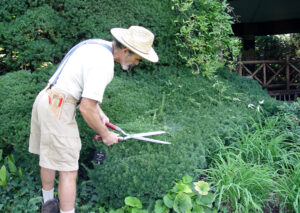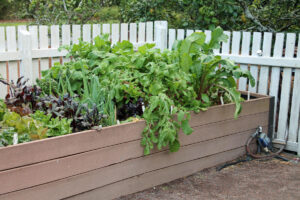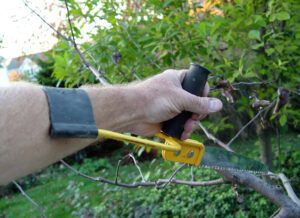How’s Your “Bounce-Backability?”
November 19th, 2024
As another growing season has come to a close, I have to confess I’m ready for a break.
On the one hand, I’ll really miss the fresh veggies, the flowers, and the walks around the yard to see what new developments are going on. But on the other, I’m tired.

Mixing up your garden jobs can help with your “bounce-backability.”
I guess that comes with Medicare territory. I knew I was heading there about a dozen years ago when I found myself thinking twice before bending over to pull a weed. My mind decided to assess whether the weed was worth the wear-and-tear on my back… and whether there was something else I could get done while down there to make the most out of the groan.
So it goes with aging gardeners. The “golden years” are great when it comes to more time to garden, but the acts of getting it all done keep getting more and more “challenging.”
Toni Gattone knows the feeling. Like many gardeners who put way more bending mileage on their bodies than couch potatoes, her back was a loud reminder that she wasn’t 30 or even 40 years old anymore.
Rather than give up her beloved hobby, this California gardener read, learned, and tried everything she could to beef up her resiliency – the ability to adapt to and quickly recover from setbacks and challenges.
“When you have more resilience, you’re never going to give up,” Gattone said in a Great Grow Along webinar. “Instead, you’re going to develop what I call ‘bounce-backability.’”
Gattone distilled her gardening bounce-backability plan into three main strategies – 1.) adapt yourself, 2.) adapt your garden, and 3.) adapt your tool arsenal.
She goes into detail in her book “The Lifelong Gardener” (Timber Press, $19.99, 2019).
Here’s the short version:
Adapt yourself
Follow the “20-20-20 rule.” Never spend more than 20 minutes doing the same task over and over. Mix garden jobs, i.e. 20 minutes of digging, then 20 minutes of pruning, then 20 minutes of raking, so you don’t overdo any one set of muscles.
Know your limits. If your balance isn’t the best, “you don’t want to be on the ladder, especially with a power tool,” Gattone says.
If you have arthritis or just weakening strength, give those heavy power tools to someone else… or find something lighter and more manageable.
And know when to quit for the day before you hurt something.
Stretch before you go out to garden. At least warm up with some kind of motion (yoga, a walk, dancing, etc.) before heavy-duty bending, digging, or lifting.
Wear quality gloves and sturdy shoes. “To try to garden in flip-flops is just not a good idea,” Gattone says.
Wear a back, knee, and/or wrist brace. If nothing else, “they remind you not to do anything silly,” she says.
Identify and head off safety hazards. Add railings to steps. Replace steps with ramps. Look around for and fix trip hazards before you go down. Fill in drop-offs along the perimeter of beds. Consider replacing loose or informal walkways with solid and level ones, such as interlocking pavers or concrete.
Stay hydrated while gardening… And keep ice packs in the freezer for when you strain something.
Ask a few key questions to zero in on changes to make, such as “What chores have become most difficult?” “What jobs can or should I delegate? and “What can I do to change to make gardening easier or more comfortable? “
Adapt your garden
Maximize your energy. Let unseen areas naturalize while focusing your limited energy on priority spots.
Add more seating, especially in the shade. “I used to love the sun,” says Gattone. “Then I got older and can’t manage the sun like I used to.”
Pay more attention to plant sizes. “If you have to do more pruning than you can handle, you have the wrong plant,” she says.

Raised beds are easier on the back.
Switch to raised beds. They’re easier to dig and plant. And if your back is really bad, you can raise them up on legs to eliminate bending altogether.
Do more eye-level gardening. Gattone suggests taking advantage of no-bend-over window boxes, hanging baskets, wall planters, and vines that grow up trellises and pergolas.
Use light-weight containers. And set them on casters so you can wheel them if need be instead of lifting.
Use self-watering planters. They reduce lugging around heavy hoses.
Adapt your tool arsenal
Look for ergonomic designs… models that fit your grip and get the job done with minimal effort. “Look for hand tools that keep your wrist straight when using them, not bent,” says Gattone.

This ergonomic saw takes pressure off the hands and takes advantage of forearm strength.
Adapt the tools you have. Examples: add rubber bike grips to your trowel handles, paint handles red or yellow to make them easier to find among plants, and above all else, keep your cutting tools sharp.
Invest in quality pruners. “You’re going to use pruners more than any other tool, Gattone says. She likes Felco and Corona brands but says that whatever brand you choose, try gripping it and squeezing it before buying.
Get a reversible kneeler bench. These function as a bench when turned one way and as a cushioned kneeler when turned the other – plus they come with side handles to help you get up and down.
Look for long-handled tools that save bending. Gattone likes the Cobra Long-Handle as a weeding/grubbing tool and Tabor Tools expandable rakes that fold up for space-saving storage.
Try a soil scoop. These have longer heads than a trowel and come with a serrated edge to cut roots and make digging easier. “This is in my top three of all my tools,” Gattone says.
Invest in a soil knife. Hori-Hori is the best known brand of this sturdy, versatile knife. “It’s great for splitting perennials and for weeding,” says Gattone. “It’s an exceptionally strong tool.”
“Resilience will not make your problems go away,” she says, “but it can help you to see past them, find joy in life, and handle setbacks when they occur.”
See more tips on adapting to gardening with age at the National Garden Bureau







